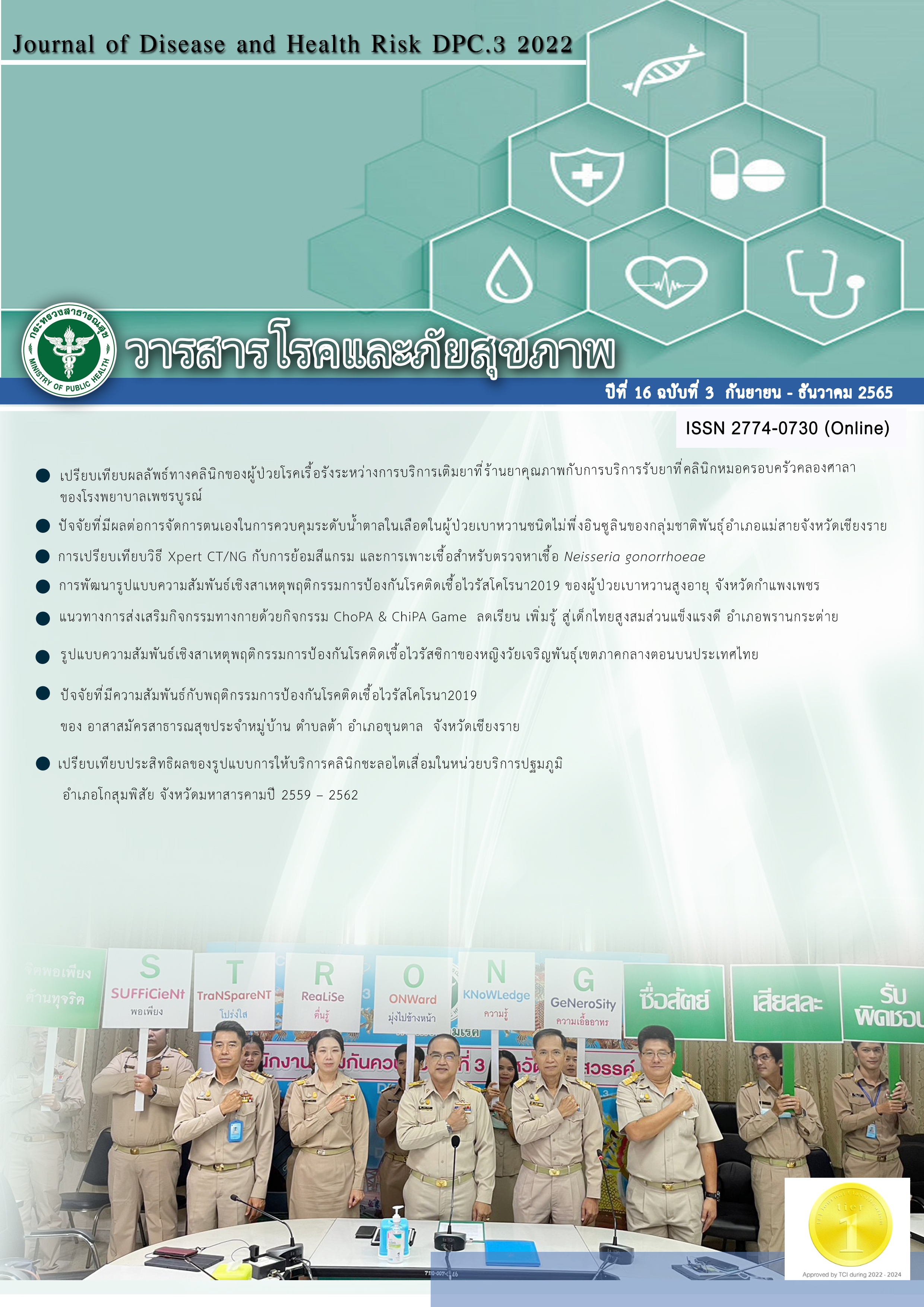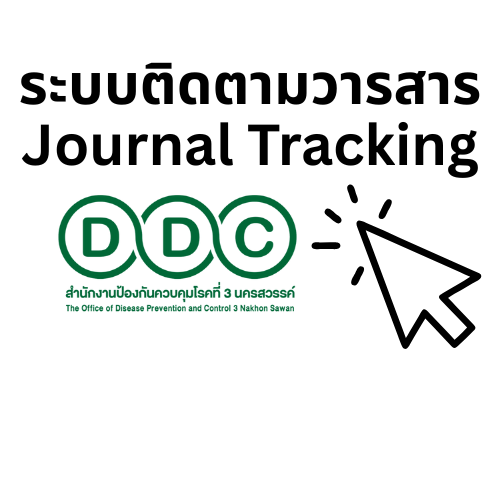Comparison of Xpert CT/NG Assay with Gram Stain and Culture for Identifying Neisseria gonorrhoeae
Keywords:
Neisseria gonorrhoeae, Xpert CT/NG assay, Gram staining, CultureAbstract
Gonorrhoea is one of the most important sexually transmitted diseases (STDs). In Thailand, the incidence is high among adolescents. This disease is caused by the contagious bacterium Neisseria gonorrhoeae. Nowadays, the molecular biology test Xpert CT/NG is used to diagnose N. gonorrhoeae from urine samples. The aim of this study was to compare the detection of N. gonorrhoeae between the Xpert CT/NG assay and the conventional assays, Gram stain and culture. 81 patients were screened for gonorrhoea at the STD clinic of the Office of Disease Prevention and Control Region 3, Nakhon Sawan, between May 2020 and January 2021. The Xpert CT/NG assay, Gram stain and culture yielded 40 positive samples (49.4%, 95% CI 38.5% - 60.3%), 33 positive samples (40.7%, 95% CI 30.0% - 51.4%) and 27 positive samples (33.3%, 95% CI 23.0%-43.6%), respectively. For agreement between the Xpert CT /NG assay with Gram stain and culture, the percent agreement and kappa were 91.4%, 0.83 and 84.0%, 0.68, respectively. The average turnaround time of the Xpert CT /NG was 1.1 days. The advantages of the Xpert CT /NG test were the high detection rate of N. gonorrhoeae, the rapid test and the simple sample collection. Due to the high costs, the Xpert CT/NG assay should be an additional test to the conventional assays to reduce false negative results and increase the accuracy of the results.
References
World Health Organization. Global progress report on HIV, viral hepatitis and sexually transmitted infections, 2021. Geneva: WHO; 2021.
Tien V, Punjabi C, Holubar MK. Antimicrobial resistance in sexually transmitted infections. J Travel Med 2020; 27(1): taz101.
European Centre for Disease Prevention and Control. Rapid risk assessment: extensively drug-resistant (XDR) Neisseria gonorrhoeae in the United Kingdom and Australia [Internet]. [cited 2022 Jan 14]. Available from: https://www.ecdc.europa.eu/en/publications-data/rapid-risk-assessment-extensively-drug-resistant-xdr-neisseria-gonorrhoeae-united
สำนักระบาดวิทยา. ระบบรายงานการเฝ้าระวังโรค 506 [อินเตอร์เน็ต]. [เข้าถึงเมื่อ 14 ม.ค. 2565]. เข้าถึงได้จาก: http://doe.moph.go.th/surdata/506wk/y64/d38_5164.pdf
Otero-Guerra L, Fernández-Blázquez A, Vazquez F. Rapid diagnosis of sexually transmitted infections. Enferm Infecc Microbiol Clin 2017; 35(7): 444-50.
Tongtoyai J, Tatakham N, Cherdtrakulkiat T, Sirivongrangson P, Hickey A. Neisseria meningitidis urethritis in a Thai male. J Health Sci Med Res 2021; 39(3): 251-5.
Bazan JA, Peterson AS, Kirkcaldy RD, Briere EC, Maierhofer C, Turner AN, et al. Notes from the field: increase in Neisseria meningitidis-associated urethritis among men at two sentinel clinics - Columbus, Ohio, and Oakland county, Michigan, 2015. MMWR Morb Mortal Wkly Rep 2016; 65(21): 550-2.
Retchless AC, Kretz CB, Chang HY, Bazan JA, Abrams AJ, Turner AN, et al. Expansion of a urethritis-associated Neisseria meningitidis clade in the United States with concurrent acquisition of N. gonorrhoeae alleles. BMC Genomics 2018; 19: 176.
Vickerman P, Peeling RW, Watts C, Mabey D. Detection of gonococcal infection: pros and cons of a rapid test. Mol Diagn 2005; 9(4): 175-9.
กลุ่มบางรักโรคติดต่อทางเพศสัมพันธ์ กองโรคเอดส์และโรคติดต่อทางเพศสัมพันธ์ กรมควบคุมโรค. คู่มือการตรวจวินิจฉัยโรคหนองในทางห้องปฏิบัติการทางการแพทย์. กรุงเทพฯ: สำนักพิมพ์อักษรกราฟฟิคแอนด์ดีไซน์; 2563.
Cepheid. Xpert® CT/NG package insert. USA: Cepheid; 2019.
Gordis L. Epidemiology. 5th ed. Philadelphia (PA): Elsevier Saunders; 2013.
Unemo M, Seifert HS, Hook III EW, Hawkes S, Ndowa F, Dillon JAR. Gonorrhoea. Nat Rev Dis Primers 2019; 5(1): 79.
Papp JR, Schachter J, Gaydos CA, Van Der Pol B. Recommendations for the laboratory-based detection of Chlamydia trachomatis and Neisseria gonorrhoeae-2014. MMWR Recomm Rep 2014; 63: 1-19.
Situ SF, Ding CH, Nawi S, Jonar A, Ramli R. Conventional versus molecular detection of Chlamydia trachomatis and Neisseria gonorrhoeae among males in a sexually transmitted infections clinic. Malays J Pathol 2017; 39(1): 25-31.
Han Y, Shi MQ, Jiang QP, Le WJ, Qin XL, Xiong HZ, et al. Clinical performance of the Xpert® CT/NG test for detection of Chlamydia trachomatis and Neisseria gonorrhoeae: a multicenter evaluation in Chinese urban hospitals. Front Cell Infect Microbiol 2022; 11: 784610.
Xie TA, Liu YL, Meng RC, Liu XS, Fang KY, Deng ST, et al. Evaluation of the diagnostic efficacy of Xpert CT/NG for Chlamydia trachomatis and Neisseria gonorrhoeae. BioMed Res Int 2020; 2892734.
Kueakulpattana N, Wannigama DL, Luk-in S, Hongsing P, Hurst C, Badavath VN, et al. Multidrug-resistant Neisseria gonorrhoeae infection in heterosexual men with reduced susceptibility to ceftriaxone, first report in Thailand. Sci Rep 2021; 11: 21659.
Adamson PC, Van Le H, Le HHL, Le GM, Nguyen TV, Klausner JD. Trends in antimicrobial resistance in Neisseria gonorrhoeae in Hanoi, Vietnam, 2017–2019. BMC Infect Dis 2020; 20: 809.
Fletcher-Lartey S, Dronavalli M, Alexander K, Ghosh S, Boonwaat L, Thomas J, et al. Trends in antimicrobial resistance patterns in Neisseria gonorrhoeae in Australia and New Zealand: a meta-analysis and systematic review. Antibiotics 2019; 8(4): 191.
Witkin SS, Minis E, Athanasiou A, Leizer J, Linhares IM. Chlamydia trachomatis: the persistent pathogen. Clin Vaccine Immunol 2017; 24(10): e00203-17.
Sarier M, Kukul E. Classification of non-gonococcal urethritis: a review. Int Urol Nephrol 2019; 51(6): 901-7.
Bradshaw CS, Tabrizi SN, Read TRH, Garland SM, Hopkins CA, Moss LM, et al. Etiologies of nongonococcal urethritis: bacteria, viruses, and the association with orogenital exposure. J Infect Dis 2006; 193(3): 336-45.
Minof GRG. A new gold standard for the detection of Chlamydia trachomatis? Infect Dis Obstet Gynecol 1998; 6(1): 44–5.
Shao L, Guo Y, Jiang Y, Liu Y, Wang M, You C, Quanzhong Liu Q. Sensitivity of the standard Chlamydia trachomatis culture method is improved after one additional in vitro passage. J Clin Lab Anal 2016; 30(5): 697–701.
Shannon CL, Klausne JD, The growing epidemic of sexually transmitted infections in adolescents: a neglected population. Curr Opin Pediatr 2018; 30(1): 137–43.
Downloads
Published
How to Cite
Issue
Section
License
Copyright (c) 2022 Journal of Disease and Health Risk DPC.3

This work is licensed under a Creative Commons Attribution-NonCommercial-NoDerivatives 4.0 International License.
Copyright notice
Article published in the Journal of Disease and Health Risk DPC.3 Nakhon Sawan. It is considered a work of academic research and analysis as well as the personal opinion of the author. It is not the opinion of the Office of Disease Prevention and Control 3, Nakhon Sawan. Or the editorial team in any way Authors are responsible for their articles.
Privacy Policy
Name, address and e-mail address specified in the Journal of Disease and Health Risk DPC.3 Nakhon Sawan. It is used for identification purposes of the journal. And will not be used for any other purpose. Or to another person.









